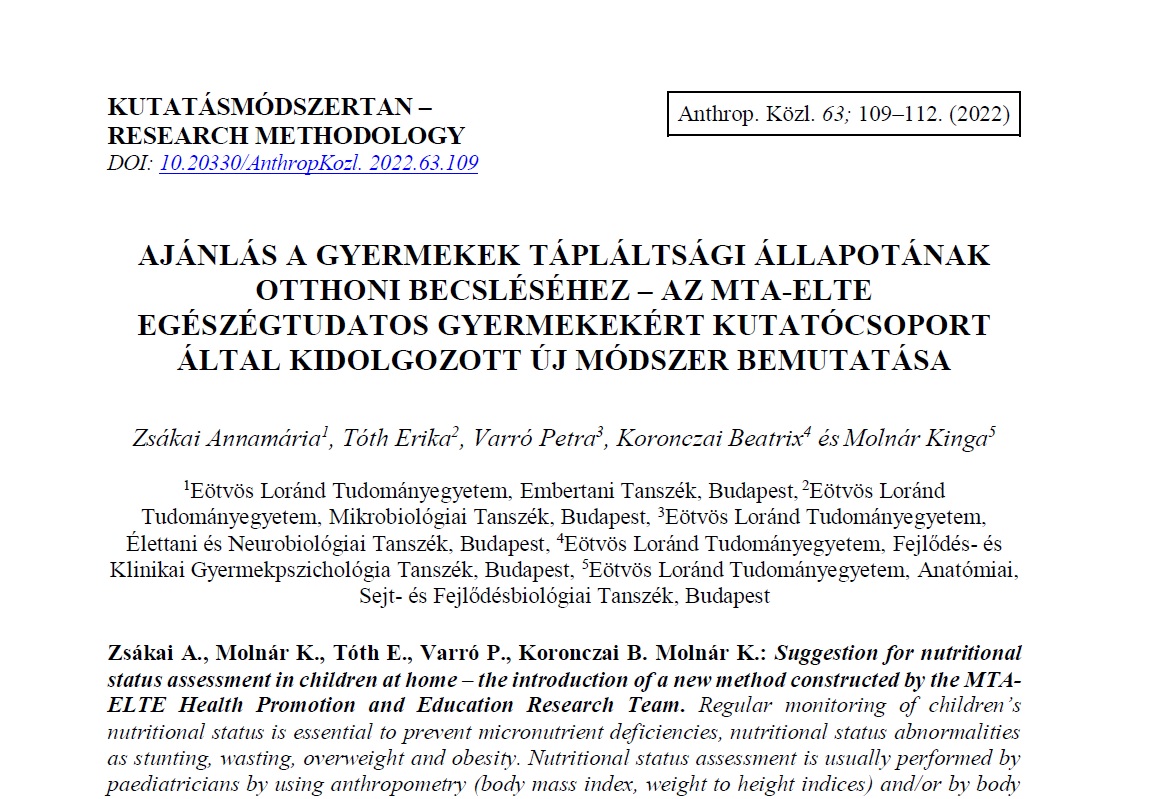Ajánlás a gyermekek tápláltsági állapotának otthoni becsléséhez – Az MTA-ELTE Egészégtudatos Gyermekekért Kutatócsoport által kidolgozott új módszer bemutatása
Absztrakt
Regular monitoring of children’s nutritional status is essential to prevent micronutrient deficiencies, nutritional status abnormalities as stunting, wasting, overweight and obesity. Nutritional status assessment is usually performed by paediatricians by using anthropometry (body mass index, weight to height indices) and/or by body fat-mass measurement (bioimpedance analysis, dual-energy x-ray absorptiometry, computer tomography, etc.). Parents are also interested in but usually fail to accurately evaluate their child’s nutritional status. The main purpose of the study was to help the sufficient collaboration between the physicians and parents by developing a new nutritional status monitoring method for families.
The new model – developed by the Health Promotion and Education Research Team, Hungarian Academy of Sciences, Eötvös Loránd University – requires age, sex, body mass, height, waist circumference and hand circumference as predictor (input) variables of nutritional status, while the centile values of the measured body dimensions, body fat percentage and the centile of body fat percentage, as well as the nutritional status category (undernutrition, normal nutritional status, overfat/obese) can be predicted (outcome variables) by the new method. The predictive accuracy of the model for nutritional status category was 94.9% in boys and 98.7% in girls.
The new model was developed for nutritional status assessment in school-aged children and will be incorporated in the healthy lifestyle module of ‘Teenage Survival Guide’ educational package to be developed by the Health Promotion and Education Research Team.
Hivatkozások
Bodzsár, É.B., Zsákai, A. (2012): Magyar gyermekek és serdülők testfejlettségi állapota. Országos Növekedésvizsgálat 2003–2006 – Body developmental status of Hungarian children and adolescents. Hungarian National Growth Study 2003–2006. Plantin Kiadó, Budapest. pp. 240
Cavazzotto, T.G., Brasil, M.R., Machado Oliveira, V., Ribas da Silva, C., Ronque, E.R.V., Queiroga, M.R., Serassuelo, H. (2014): Nutritional status of children and adolescents based on body mass index: agreement between World Health Organization and International Obesity Task Force. Revista Paulista de Pediatria, 32: 44–49. DOI: https://doi.org/10.1590/S0103-05822014000100008
Cole, T.J., Bellizzi, M.C., Flegal, K.M. & Dietz, W.H. (2000). Establishing a standard definition for child overweight and obesity worldwide: international survey. British Medical Journal, 320(6): 1–6. DOI: https://doi.org/10.1136/bmj.320.7244.1240
Cole, T.J., Flegal, K.M., Nicholls, D., Jackson, A.A. (2007): Body mass index cut offs to define thinness in children and adolescents: international survey. British Medical Journal, 335(7): 194–207. DOI: https://doi.org/10.1136/bmj.39238.399444.55
Utczás, K., Muzsnai, Á., Cameron, N., Zsákai, A., Bodzsár, É.B. (2017): A comparison of skeletal maturity assessed by radiological and ultrasonic methods. American Journal of Human Biology, 29(4): e22966. DOI: https://doi.org/10.1002/ajhb.22966
Zsákai, A., Bodzsár, É.B. (2012): The 2nd Hungarian National Growth Study (2003–2006). Annals of Human Biology, 39(6): 516–525. DOI: https://doi.org/10.3109/03014460.2012.717965




